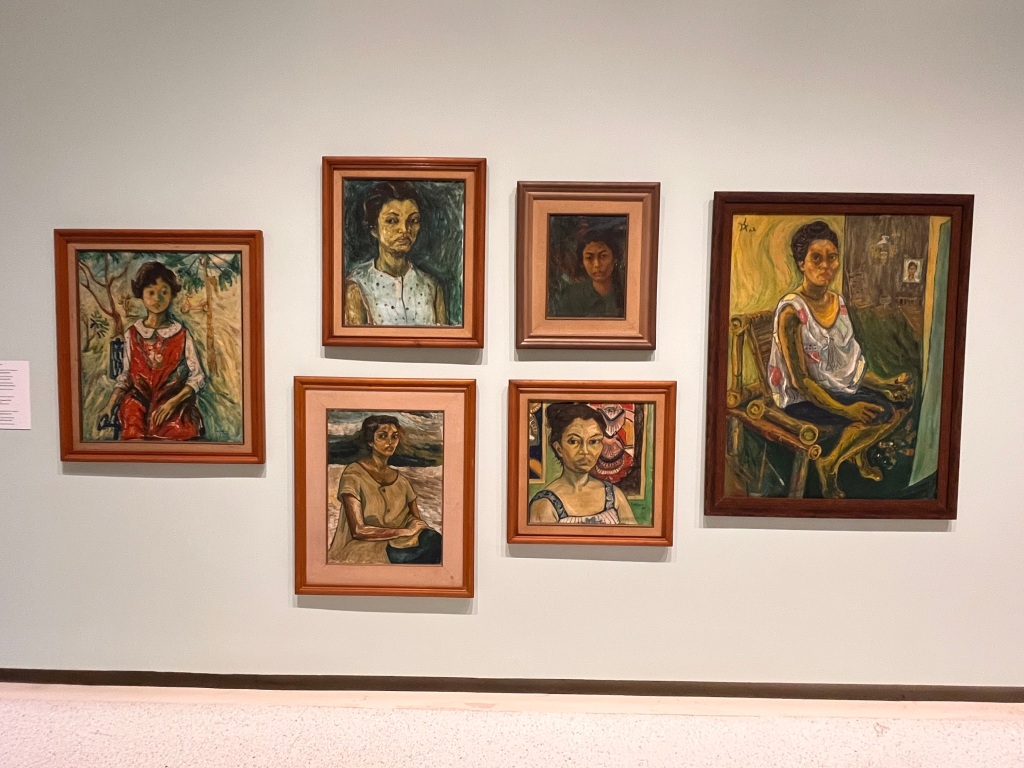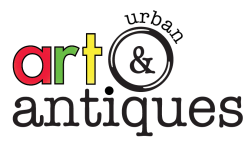If you went to Carnegie International this year looking for a survey of contemporary artwork and artists, what you encountered is probably not what you expected. What’s on view is a mix of commissioned works, found works and historical works, some of it beautiful, most of it disconcerting and altogether quite heavy. It’s a tour through the horrors of history and a bleak look into the future. As one guide chimed in and pointed toward a William Bouguereau painting, “if you don’t like it you can go over there, what you’ll find is quite classic.”

I did find something I have truly enjoyed. Sanaa Gateja’s work with paper beads on bark cloth is both instantaneously unique but also brings to awareness its positive social and environmental impact through its process and material. Numerous beads create a tapestry of harmonious colors. Their subtle arrangement also alludes to sculptural depth, movement and scintillating light. In particular, Together enters the Carnegie Museum of Art through the exhibition, as the tradition of building a collection through “masters of tomorrow” continues. Needless to say, Bead King of Uganda is not a master of tomorrow, nor any artist invited to such a major international contemporary art survey. Still, I am glad the art advisory board of the museum has chosen such a phenomenal work.

The research and the preparation of this Carnegie International cycle largely overlap the pandemic. Before I started the tour, I imagined that covid could dominate the narrative. When physically confined, artists must look through neighborhoods and look inward and to nature. Such narratives are included. Notably, Latoya Ruby Frazier’s monumental installation of her photograph and interview of community health workers in Baltimore. Monumentality can also be aptly applied to the effort for visitors. I wonder if anyone has read through all 33 text panels. Yet without text, the experience is like reading a book by combing through the illustrations only. On the other side of the spectrum, OK Studio, a multi-media installation by Julian Abraham “Togar,” brings an ocean breeze and soothing music for a reprise.
But the curatorial team lay their eyes on a much longer time horizon. The geopolitical conflicts of the last eight decades, imprinted under the U.S. global influence, are on full display. To some degree, the longer horizon implicitly answers the question from the exhibition’s title: “Is it morning for you yet?” The anxiety and troubles of our current time seem lessened when historical artistic expression is brought in for comparison. We have been there. And certainly, it can always be worse.

The Dogma Collection amazed me in that, through the discerning eyes of the curatorial team, the work of anonymous artists could rise to such historical significance. A group of propaganda posters from North Vietnam was hanging afloat, all facing toward the center of the room. On the back of them, artists and art students repurposed them for figure drawing. Neither the posters nor the charcoal drawings are, by themselves, worthy of inclusion. But seeing the juxtaposition forces human beauty to co-exist with propaganda and sends a chill down my spine. This is connoisseurship at its best.

The mixture with historical works from global institutions eventually got me confused, when I had to ask a museum staff member if there was another separate exhibition on works by Kustiyah, a retrospective on a woman painter from Indonesia spanning five decades of her throughput. The artworks just look and feel different. Indeed the core team has relinquished the curatorial role to another team. The result was an exhibition within an exhibition with its own focus and style. I had never heard of the artist before. Her representational work has strong characters and styles. They remind me of early Texas art. But without reading the introduction, most of her work did not allude to its impact in “galvanizing social and political movement.”
On the other hand, Pacita Abad’s work depicting the social unrest during the Jakarta riots feels more contemporary, despite the fact that the artist passed away in 2004 and the riots happened in 1998. Since then, we have seen history repeats like stanzas, from the downfall of Mubarak in Arab Springs to the current Tel Aviv protest against Netanyahu. But its immediacy and relevancy, at least for me, is due to the strong visual resemblance to my memory of social unrest in the U.S. such as BLM or the January 6 event.

The Hall of Sculpture, where six paintings by Abad are, is my favorite space in the whole show. Mohammed Sami’s work is a rarity here, as they are loaned instead of commissioned by Carnegie International. The airy and bright upstairs balcony gives Sami a spotlight that large works by other artists lack. For reference, Krista Belle Steward’s wall mural is literally next to a ticketing line.
On the one hand, Sami’s work is channeled into critical moments that define the modern era of the Arab world, except he buries them deep and invites viewers to unlock their own memory with fragmented visual cues. In The Fountain, the water feature of a plaza fountain looks more like flames from a burning oil pit. Behind the flames looms large the statue of Saddam Hussein, toppled from Bagdad in 2003. Not afar, a piece of clothing hanging on the wall is delicately rendered, with the title Abu Ghraib. The dark green pants and their shadow are meant to create a moment of tranquility until I realized the whole imagery resembles a leaked photo from Abu Ghraib in 2004. In that photo, a completely covered prisoner was told he would be electrocuted if he fell out of a box that he was standing on.

On the other hand, Sami resorts to mundane objects to reflect the aftermath of war and horrors. Even in its most direct observation, like 23 years of nights, his virtuosity in handling the paint creates suspense and unease that pushes viewers to uncover. In that painting, the extraordinary texture of the wood board and gossamer-thin curtains recall the tradition of Islamic art. Then it becomes clear to me that a curtain would be useless as the window is boarded up. The imprinted stars from the curtains would be the only nightly feature seen from inside the house for the last 23 years, ever since the Iraq war in 1999.

If the violence of the war is too subtle in Sami’s work, his contemporary fellow Dia al-Azzawi’s full-room installation Ruins of Two Cities: Mosul and Aleppo immerse viewers in the human tragedy through a birds-eye view. It suddenly occurred to me that probably in the same room four years ago, I was sipping freshly made coffee and resting in a hammock in the previous Carnegie International. Instead of having fun, I was exploring subjects like house confinement and torture (Kate Millet), Hiroshima collections (Hiromi Tsuchida), woman laborers in the Panama Canal (Giana De Dier), and a sculpture that spun out material like the human intestine (Mire lee) – it was just too much an ask to absorb one more “ugliness of what man does to his fellow man.”
Not everyone can be involved in the military, government, or politics, which have a direct impact on human rights. But ordinary people, once inspired and motivated, can and will stand up to fight against tyranny and injustice, as seen in Abad’s Indonesian riot, or Nikki Arai’s photograph of Asian American political activists. Artists, through documenting and creating thought-provoking work, leave a materialistic legacy that serves as a catalyst to inspire and motivate the generations to come.

To some extent, I appreciate the black humor from Banu Cennetoglu’s installation. Titled Right? she piles many gold-letter helium-inflated balloons in the center space of the Hall of Sculpture. By the time we visited there, most of the balloons began to deflate and collapse into inseparable piles. That exactly validates her points: Without the labor of protecting, extending, and upholding them, can any rights remain?
To be sure, there is a lot to be pessimistic about historically and contemporaneously and it’s tempting to want to confront it. To that end, the exhibit is engaging and thought-provoking. Much of the artwork is magnificent if you let it speak for itself. Yet you can’t help but think the curators are speaking through it. Perhaps the focus was chosen in an effort to encourage awareness at a critical time in world history. And in doing so, aim for increased relevance. Of course, not engaging with doom won’t make it go away, and to many people, art at its best has something to say. But maybe this edition of the international is trying to say too much. International as it is, the weight of the world may be too great for the Carnegie and its audiences.
Just having this long-standing important survey of contemporary art far away from the coasts and major cultural centers is in itself an important goal that shouldn’t get lost in themes, especially big ones. As you leave the museum you may have been a bit surprised, your car is still in the lot. The world has not ended. There will be another Carnegie International and I hope it’s something artists on all sides of morning can continue to look forward to.


